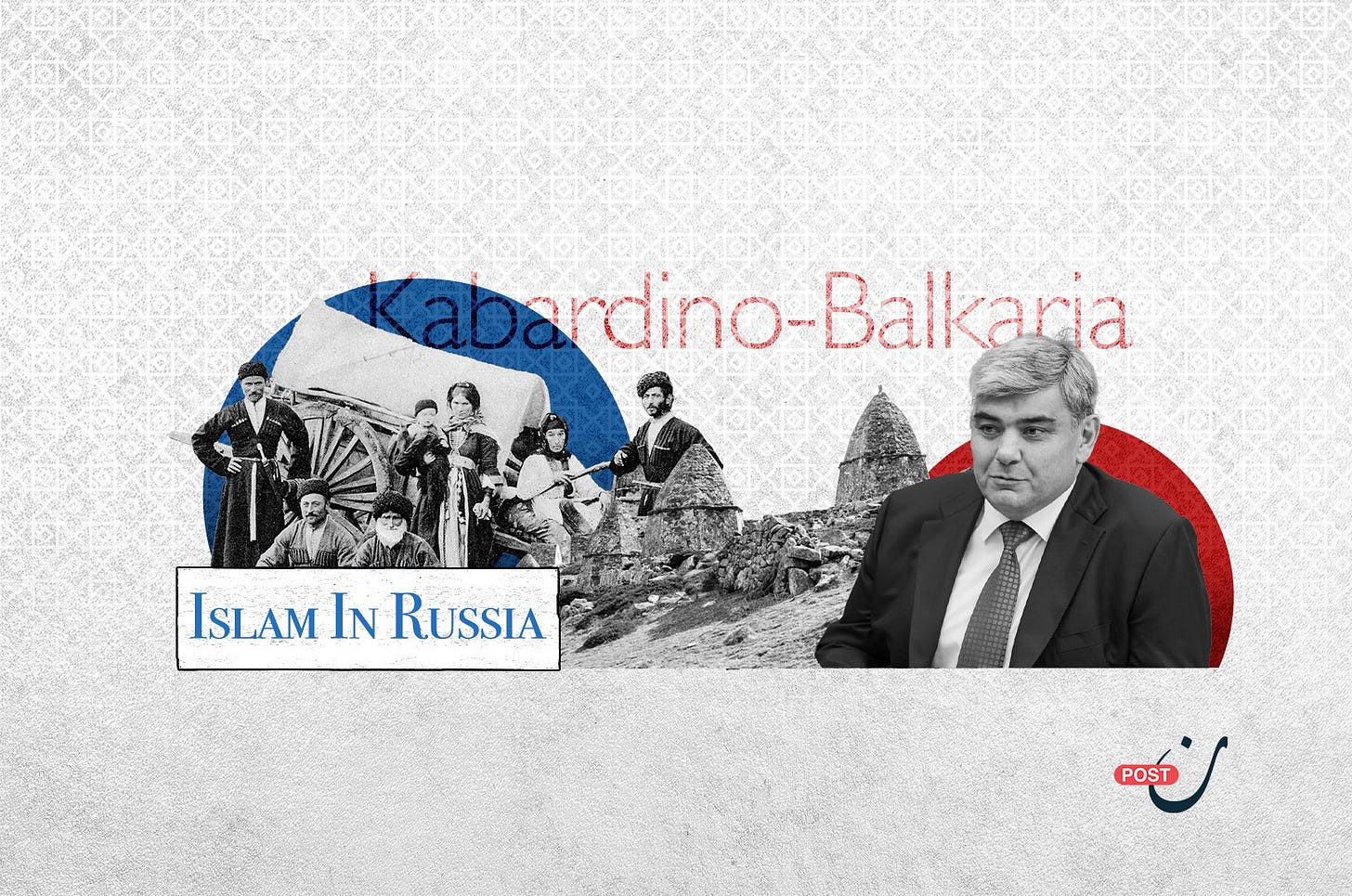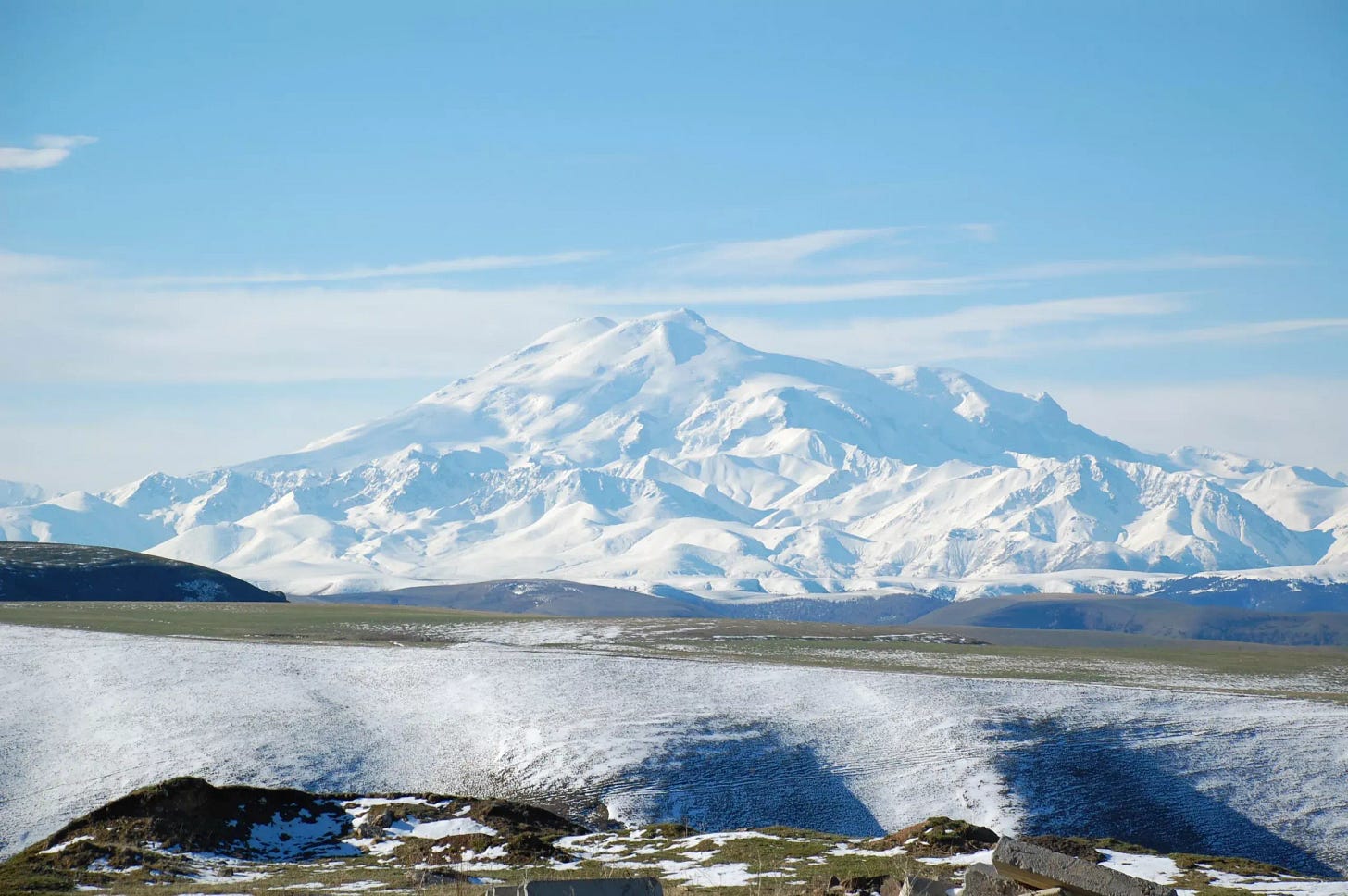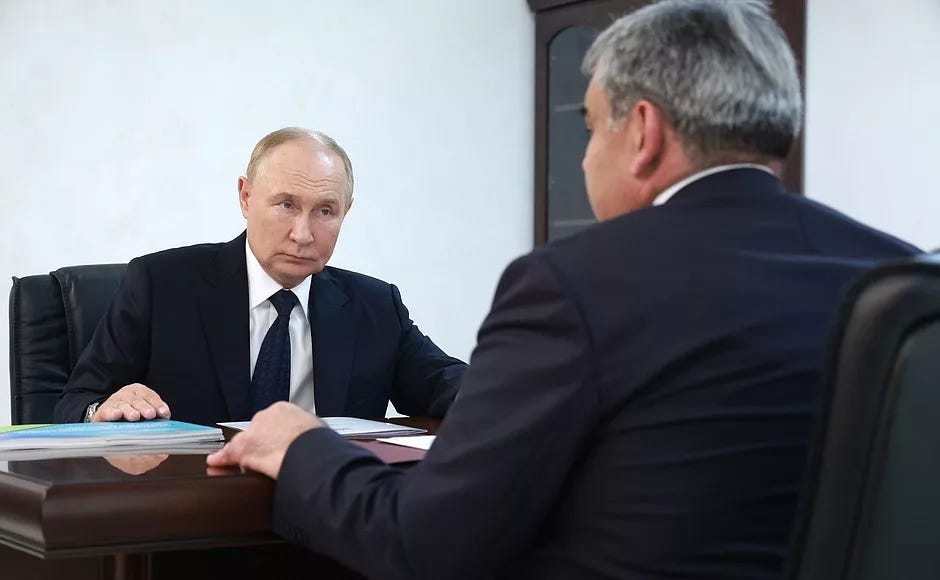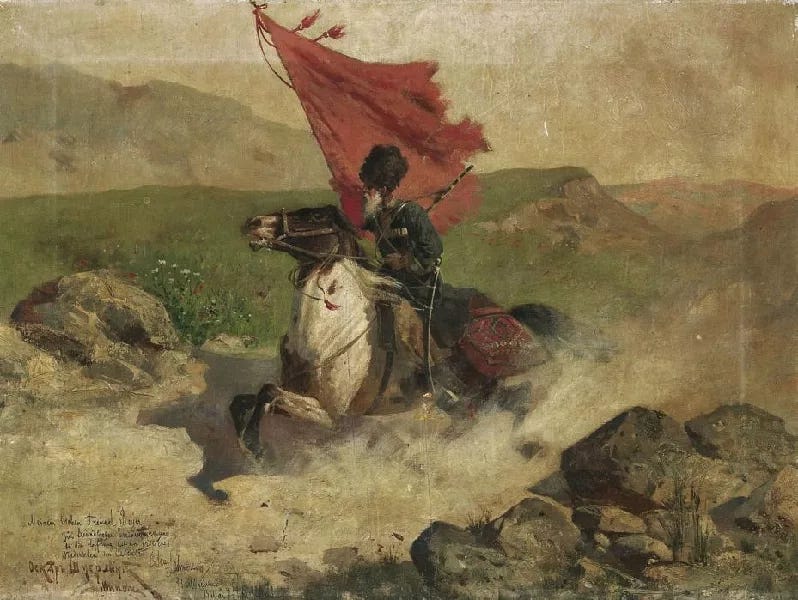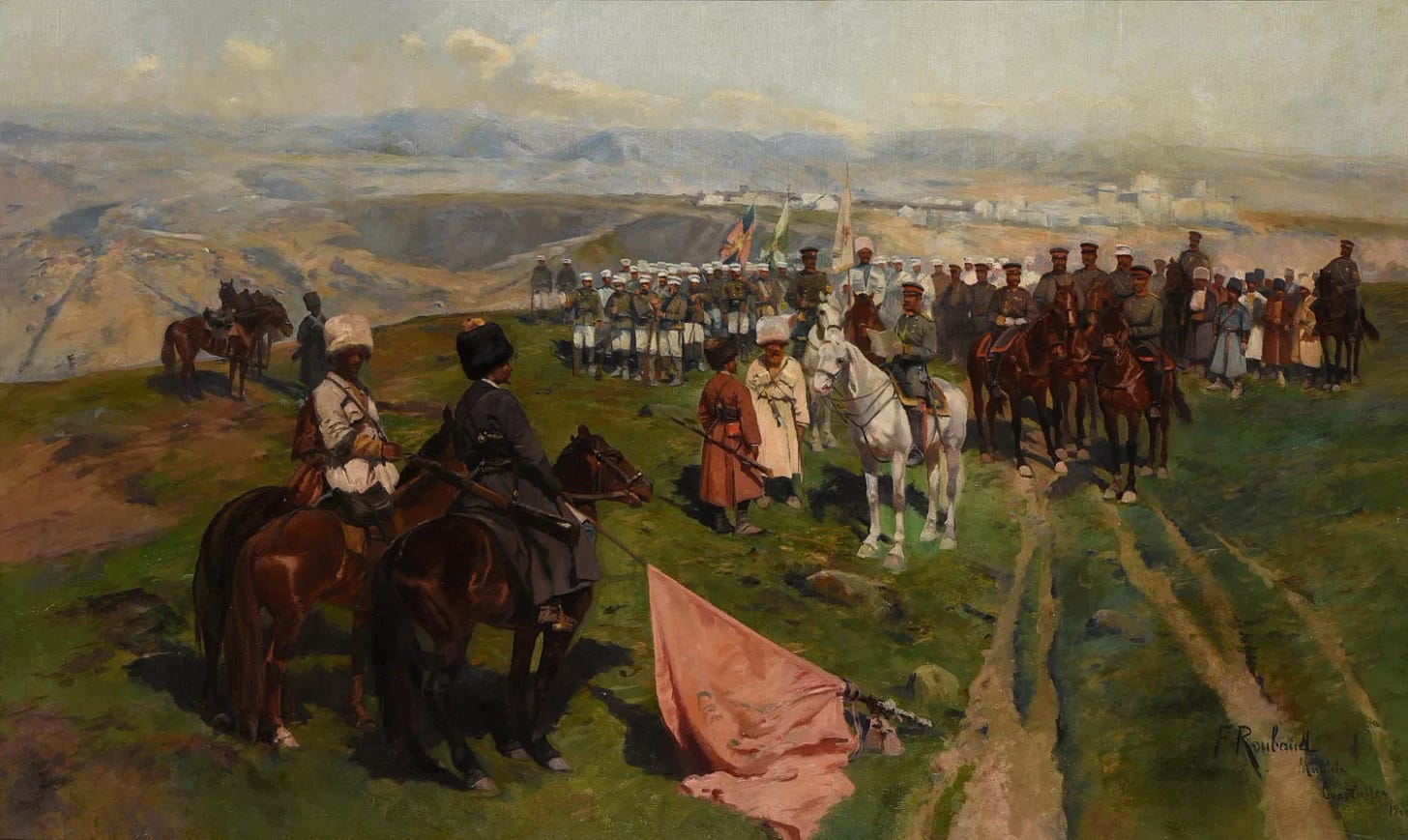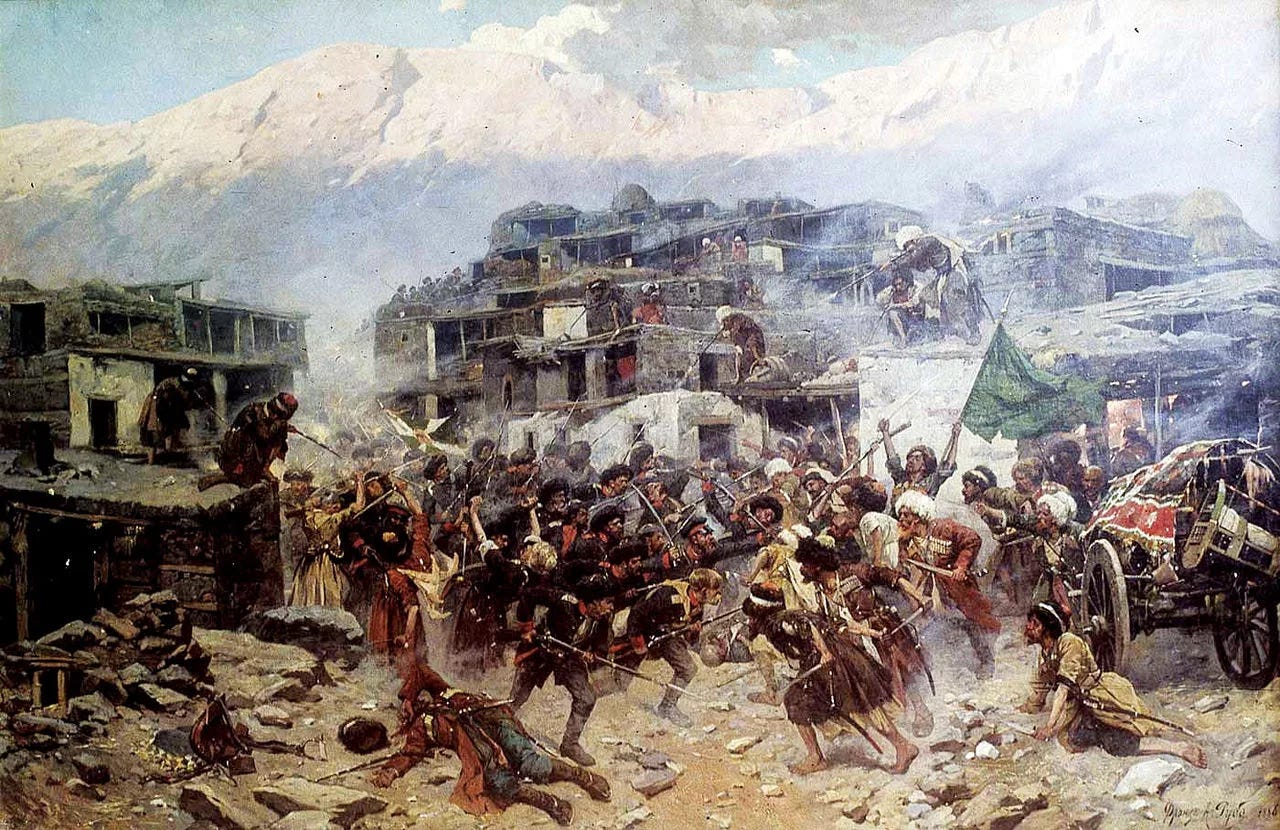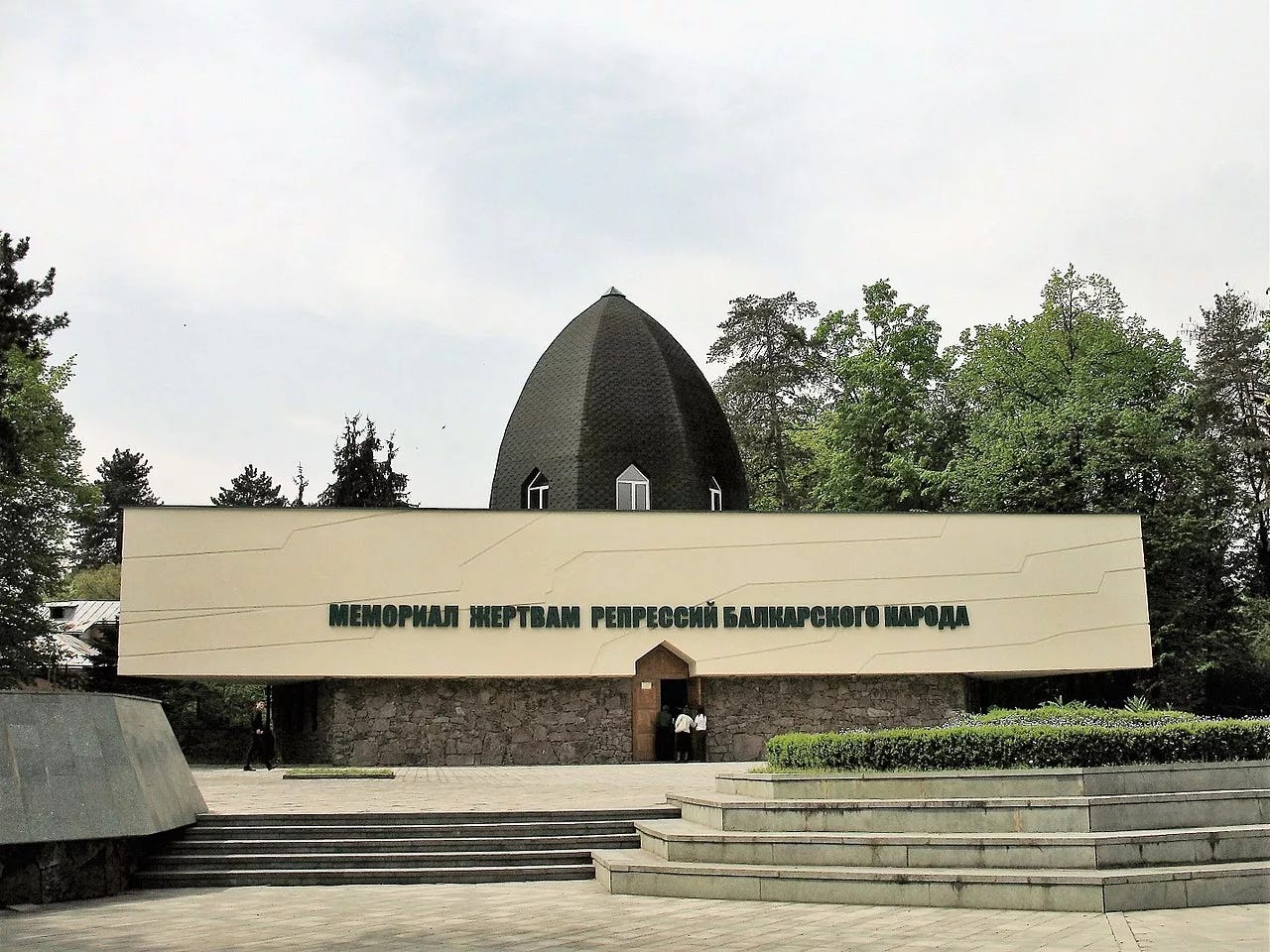Nestled in the heart of the North Caucasus, Kabardino-Balkaria spans 12,500 square kilometers and stretches across 696 kilometers of borders. To its south lies Georgia, while Stavropol Krai borders it from the north. North Ossetia lines its east and southeast, and to the west is Karachay-Cherkessia. The republic is home to some of the world’s greatest glaciers.
Kabardino-Balkaria is a young republic with a population of about 900,000, comprising three primary ethnic groups. The Kabardians, who make up 57% of the population, inhabit the plains. Ethnic Russians constitute 23%, while the Balkars—a Turkic-speaking highland people—represent 13%.
The rest are from various other ethnic backgrounds. The majority of Kabardians and Balkars are Sunni Muslims adhering to the Hanafi school of jurisprudence.
This article is part of the “Lands of Islam in Russia” series, which explores the history of Siberia and the Muslim-majority republics of the North Caucasus—Chechnya, Ingushetia, Dagestan, Kabardino-Balkaria, and Karachay-Cherkessia—as well as Tatarstan and Bashkortostan.
Together, these regions are home to an estimated 25 million Muslims.
Behind Bars
Kabardino-Balkaria holds significant geopolitical importance for Russia as a vital transit point in the North Caucasus. Geographically, the region is divided into 33% plains, 16% uplands, and 51% mountainous terrain.
It boasts rich natural resources, a robust agricultural sector, and considerable livestock. With over 3,300 plant species, around 100 mineral springs, and more than 100 lakes, its industrial sector accounts for roughly 60% of its income.
Residents work in traditional crafts, agriculture, and livestock breeding—including horses, cattle, goats, and sheep. Carpet weaving remains a prominent craft in the mountains. In recent years, Kabardino-Balkaria has also become a notable tourist destination.
Since the early 2000s, Islamic activity has flourished, marked by a rise in mosques and religious institutions. Religion has gained a renewed role, particularly among younger generations often referred to as “New Muslims.”
Despite its potential, the republic suffers from severe socio-economic challenges—plummeting living standards, high unemployment, rampant corruption, and organized crime. These issues render Kabardino-Balkaria one of the poorest regions in the Russian Federation, even though its resources could ensure prosperity.
A primary reason for the unemployment crisis is the near-total exclusion of local farmers from land lease opportunities. Although 55% of the territory is arable, most of this land has been leased long-term—49 years with renewal rights—to officials and their relatives from other Russian regions, bypassing local citizens.
Beyond poverty and disenfranchisement, Moscow has spent the last 25 years systematically dismantling the republic’s national identity. Under the pretext of combating separatism, it has targeted Kabardians and Balkars alike. Russia fans the flames of ethnic tensions between them while avoiding meaningful political or economic reform.
Today, Russian is the official language, with Kabardian and Balkar recognized as secondary. However, both are discriminated against, absent from official documentation, commerce, and governance. Few people speak them fluently.
Russian is now compulsory in schools, and primary schools that once taught in Kabardian or Balkar have been shut down. At best, these native tongues are reduced to a single weekly hour in public education.
The republic is littered with monuments honoring Russian figures who led oppressive campaigns against indigenous populations. Streets bear the names of Bolshevik leaders and military officers. Each September, Kabardino-Balkaria is compelled to celebrate the 450th anniversary of what Moscow calls its “voluntary accession” to Russia.
In reality, there have been minor separatist movements in the region. Some Balkars have sought their own republic, while Kabardians have expressed desires for independence from Moscow. Although these efforts haven’t reached the scale seen in other North Caucasus republics, recent years have witnessed an uptick in violence.
Jihadist ideology has also gained traction. Official reports suggest around 200 citizens joined ISIS. Russian security forces continue to launch lethal raids and mass arrests under the banner of combating “separatists and terrorists.”
Land and Traditions
Kabardians and Balkars are indigenous peoples of the North Caucasus. The Kabardians belong to the Circassian ethnic group, originally consisting of 18 tribes. Only 10 remain today, most living outside their ancestral lands and identifying as Adyghe.
Despite Russian-imposed divisions that categorized Circassians into four distinct administrative units, they are one people. As of the 2021 census, their total population in Russia stood at 751,487.
The Balkars, neighbors to the Kabardians, are a small Turkic tribe dwelling in the central Caucasus mountains, numbering about 71,000. They share ethnic ties with the Karachay.
Historically, the Balkars lived in highland villages, while Kabardians farmed the plains and raised livestock. Though they speak different languages, the two communities have coexisted and traded for centuries.
Social life in Kabardino-Balkaria was long governed by customs and traditional councils. These councils handled war, peace, land disputes, family conflicts, and national affairs, which were discussed by the nobility.
The Kabardian language, a Circassian dialect, was originally written in Arabic, later switched to Latin, and finally Cyrillic in 1936. The Balkar language followed a similar path, transitioning to Cyrillic in 1939.
The Kabardians were initially pagan, later influenced by Christianity. Islam spread among them in the 16th century through Ottoman and Crimean Tatar contact, especially via Black Sea ports. By the early 19th century, most Kabardians were Hanafi Sunni Muslims.
The Balkars adopted Islam in the 18th century through their relationship with the Circassians.
Historically, both groups relied on agriculture and livestock—especially horses, prized for their speed and agility, and even used by imperial armies. The Kabardians cultivated the best pastures between Mount Elbrus and the upper Malka and Kuma rivers.
Among Circassians, no figure is more revered than Prince Inal the Great, who unified the Circassians between 1427 and 1453 after the Mongol invasion. His state stretched from the Don River to the Caucasus and from the Black Sea and Crimea to Chechnya.
He divided Circassia into regions, one of which was Kabardia. After his death, Kabardia became independent.
Empire-Building: The First Encounter
Kabardia’s internal strife among princely families led to its division into Greater and Lesser Kabardia in the late 16th century. Facing repeated attacks from the Crimean Khanate, Kabardian prince Temryuk Idar allied with Russia in 1557, marrying his daughter to Tsar Ivan IV.
This alliance deterred Crimean threats and maintained equal relations with Russia until the mid-18th century.
The 1739 Treaty of Belgrade between Russia and the Ottoman Empire acknowledged Kabardia as a neutral buffer state. However, under Empress Catherine II, Russia began fortifying Kabardia’s northern border. In 1763, it built the Mozdok fortress to facilitate occupation and settlement.
The Ottomans protested the move in 1764, and Kabardian nobles petitioned Saint Petersburg to demolish the fortress, but their plea was rejected. In 1769, Russia launched its first military campaign into Kabardia.
During the Russo-Turkish War (1768–1774), Kabardian nobles welcomed Ottoman forces. Alongside Crimeans and Ottomans, they attacked Russian positions, including Mozdok. But Russia ultimately prevailed and annexed Kabardia.
Expecting future Ottoman conflicts, Russia fortified the North Caucasus with military bases and resettled Cossacks, sparking widespread Circassian rebellion. From 1777 onward, Kabardian armies launched coordinated raids against Russian garrisons. They forged alliances with neighboring Caucasian communities such as Chechens and Dagestanis.
Though initially successful, Russian forces crushed the resistance by late 1779, redrawing borders to restrict Kabardian movement, severing their access to vital lands and pastures.
Following another Russo-Turkish victory (1787–1793), Russia replaced Islamic courts in Kabardia with ones based on Russian law, provoking a mass uprising. It was crushed in May 1805, but Moscow begrudgingly reinstated the Islamic judicial system.
The Final Conquest: Plague and Deportation
The early 19th century brought demographic catastrophe to Kabardia. A devastating plague decimated 90% of the population, reducing it from 350,000 to just 50,000 by 1818. Historian Ian Lanzilotti notes this cleared the path for Russia’s complete conquest of Kabardia.
General Yermolov, the architect of the final occupation, praised the plague’s effect, saying:
“The plague was our ally—it weakened the Kabardians so much that they could no longer muster a defense. Otherwise, our army would have been in grave danger.”
Yermolov’s strategy involved building fortresses, resettling Ossetians and Cossacks, and displacing Kabardians. This dismantled their independence and ruined their livestock-based economy.
By the late 1820s, Kabardia was firmly under Russian control. After a century-long war, from 1862 to 1864, Russia exiled about 90% of the Circassians—including thousands of Kabardians. Their descendants now live across the Middle East, particularly in Turkey, Syria, and Jordan.
Many Kabardian pastures were left unused, prompting Balkar settlers to utilize them. This later fueled disputes as Kabardians sought to reclaim ancestral lands. Ossetian and Slavic settlers also moved in, further complicating land ownership.
The Soviet Republic of Kabardino-Balkaria
In 1912–1913, Kabardia witnessed a short-lived uprising against Tsar Nicholas II. Following the February Revolution of 1917, the North Caucasus intelligentsia formed a political movement to represent mountain peoples. In May 1917, delegates gathered in Vladikavkaz and proclaimed a federal republic.
Kabardia declared independence and joined the Mountainous Republic of the North Caucasus, which lasted until 1924. But both the Red and White Russian factions viewed this republic as an obstacle and worked jointly to crush it.
After the Russian Civil War, Moscow split Kabardia and Balkaria into two ethnic-based territories. Yet local leaders agreed on a compromise—shared governance and land—which led to the formation of a unified administrative region: the Kabardino-Balkarian Autonomous Region.
In 1928, the Kabardians revolted against Soviet repression, but the uprising was crushed. Stalin's systematic purges in the 1920s and '30s decimated Islamic institutions, shuttering schools, courts, and religious education. By 1961, only 13 mosques remained in the republic.
Despite the Kabardians’ and Balkars’ sacrifices during WWII, Stalin accused the Balkars of collective treason. On March 8, 1944, Soviet forces stormed the highland villages, announcing immediate deportation. Resistance was met with bullets.
Roughly 37,713 Balkars and 2,000 Kabardians were forced into cattle cars and sent to desolate steppes in Kazakhstan and Kyrgyzstan. Northeastern Kabardia was handed to North Ossetia, another portion to Georgia. The Balkars’ name was struck from the republic’s title.
As one of the smallest and most vulnerable Caucasian ethnicities, the Balkars suffered heavily—Soviet figures suggest that 20% died in exile. In 1957, Khrushchev allowed their return and restored the republic’s original name.
Kabardino-Balkaria After the Soviet Union
Following the USSR’s collapse, Kabardino-Balkaria declared sovereignty in 1991. Tensions between Kabardians and Balkars quickly flared over disputed lands. In December 1991, Balkars voted to form a separate republic. Ultimately, both groups agreed to remain unified under Russian federation control.
Since independence, the republic has had four presidents: Valery Kokov (1992–2005), Arsen Kanokov (2005–2013), Yury Kokov (2013–2018), and Kazbek Kokov (2018–present).
Valery Kokov ruled through 2005 and adhered strictly to Putin’s centralization agenda, suppressing Islamic movements. His successor, Arsen Kanokov, initially appointed for his integrity, adopted even more authoritarian measures and aligned closely with Moscow’s elite.
With mounting unrest, the Kremlin replaced Kanokov in 2013 with General Yury Kokov. While Yury successfully suppressed Islamist militancy, his heavy-handed tactics exacerbated ethnic tensions, leading to his resignation in late 2018.
That year, the Kremlin installed Kazbek Kokov, a civilian leader, who pledged to ease tensions, promote national cohesion, and improve the investment climate.
Nevertheless, Kabardino-Balkaria remains tightly controlled by Moscow. Putin continues to rely heavily on military and security apparatuses. Even in the absence of active conflict, deep-rooted grievances remain among Kabardians and Balkars—resentful of Russia’s dominion over their history and present.


